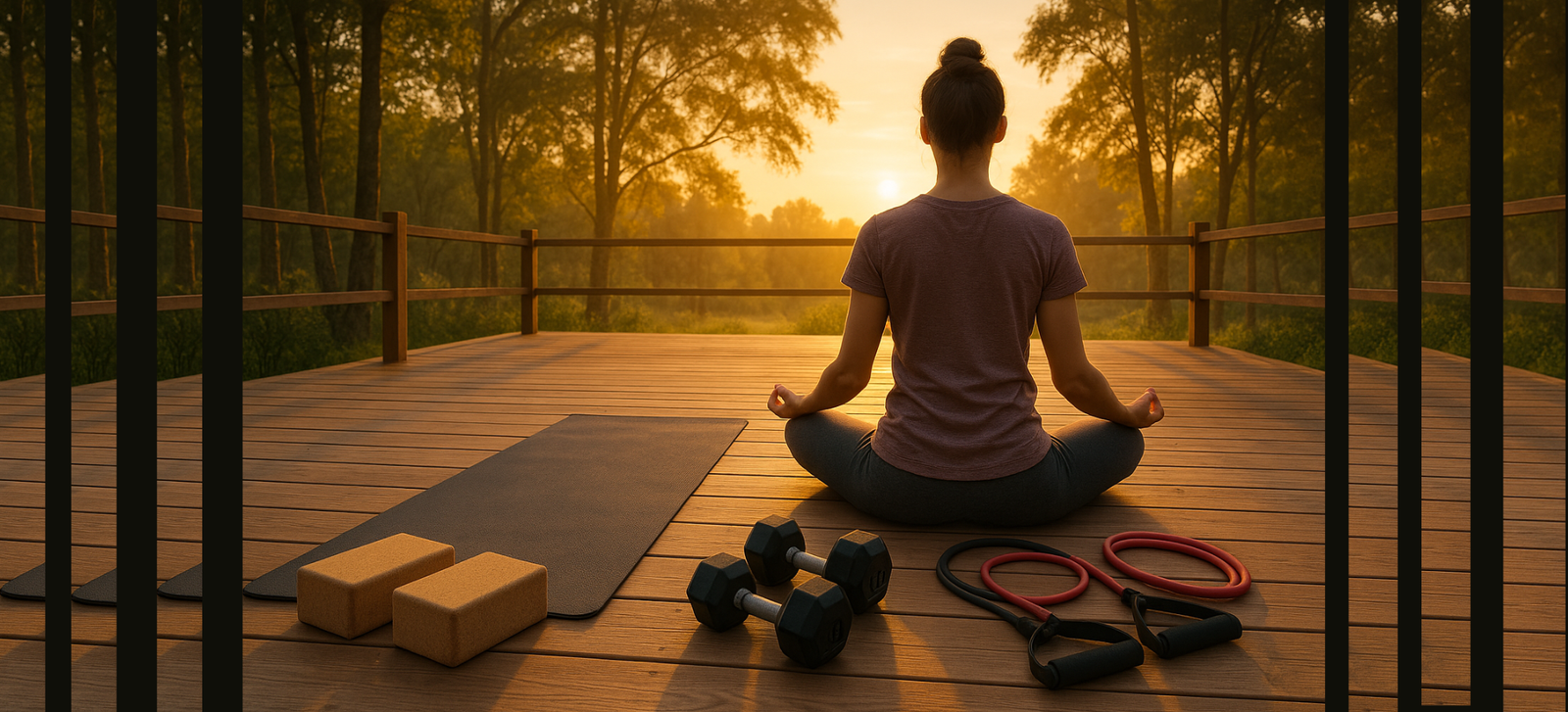Build muscle without sacrificing mindfulness. A spiritual approach to strength training that honors both your body and soul. Get ripped the conscious way.
I was doing sun salutations in my apartment when my neighbor knocked on the door.
“Dude, what’s that thumping sound every morning at 6 AM?”
Thumping sound? I was flowing through gentle yoga sequences, not renovating the kitchen.
Then I realized: my “gentle” practice had evolved. Somewhere between chanting Om and chasing enlightenment, I’d started adding pushups to my flow. Jump-back chaturangas had become actual strength moves. My yoga mat was sharing space with dumbbells.
I was becoming a spiritual meathead. And honestly? It felt amazing.
The False Choice
Western culture loves binary thinking. You’re either spiritual OR physical. Mindful OR muscular. Enlightened OR jacked.
This is complete nonsense.
Some of history’s most realized beings were also physical powerhouses. The Shaolin monks didn’t choose between meditation and martial arts—they integrated them. Ancient yogis weren’t frail ascetics—they were warriors who could hold challenging poses for hours.
Dr. Sara Lazar’s neuroimaging research at Harvard shows that both meditation and exercise create similar beneficial changes in brain structure, particularly in areas related to attention and emotional regulation. <cite>¹</cite> Your brain doesn’t distinguish between spiritual and physical practices—it responds to both as forms of beneficial stress.
The Ego Trap in Both Worlds
Here’s the thing nobody talks about: spiritual bypassing and muscle dysmorphia are the same disease with different symptoms.
In spiritual circles, people use meditation to avoid dealing with their bodies. They transcend rather than transform. They float above their physical reality instead of inhabiting it fully.
In fitness circles, people use their bodies to avoid dealing with their minds. They lift away their feelings. They sculpt their outside while their inside remains chaotic.
Both are forms of escape.
Integral philosopher Ken Wilber writes, “The ego is not the enemy; it is the vehicle. The problem is not that we have an ego, but that we are not more than our ego.” <cite>²</cite> Whether your ego is attached to being “above” physical concerns or obsessed with physical perfection, it’s still ego.
The Integration Path
Real transformation happens when you stop choosing sides and start integrating opposites.
I learned this during my darkest period. After a spinal injury that left me unable to do traditional yoga for months, I was forced to rebuild my relationship with my body from scratch.
Physical therapy became my spiritual practice. Every exercise was a meditation on presence, patience, and acceptance. Every rep was a prayer for healing. Every small improvement was a lesson in gratitude.
Buddhist teacher Thich Nhat Hanh teaches that “your body is your first home,” and treating it with reverence is a form of spiritual practice. <cite>³</cite> You can’t love yourself while hating your vessel.
The Sacred Science of Strength
Building muscle mindfully isn’t about grinding through workouts with spiritual background music. It’s about approaching strength training as a contemplative practice.
Here’s how I’ve learned to integrate the two:
Intention Setting: Before each workout, I spend two minutes in stillness, connecting with why I’m training. Not just physical goals, but how strength serves my capacity to serve others.
Research by sports psychologist Dr. Costas Karageorghis shows that mindful intention-setting before exercise significantly improves both performance outcomes and psychological benefits. <cite>⁴</cite> When you train with purpose beyond appearance, everything changes.
Breath as Teacher: In yoga, breath guides movement. In strength training, breath creates stability and power. The Valsalva maneuver used in heavy lifting is essentially pranayama under load.
Progressive Overload as Spiritual Practice: The principle of gradually increasing resistance mirrors spiritual growth. You don’t meditate for 10 hours on day one. You don’t deadlift twice your bodyweight immediately. Both require patience, consistency, and respect for process.
The Protein Paradox
One of the funniest challenges of being a spiritually-minded fitness enthusiast is navigating the protein obsession.
“Bro, you need 1.8 grams per kilogram of bodyweight.” “But also, attachment to outcomes is the root of suffering.”
The middle path? Understanding that nutrition is medicine, not morality.
Ayurvedic practitioner Dr. Vasant Lad teaches that food becomes part of our consciousness, so choosing what we eat mindfully affects both physical and spiritual development. <cite>⁵</cite> You can honor your body’s need for protein while maintaining a healthy relationship with food.
I eat to fuel my practice, not to feed my ego. Some days that looks like a protein smoothie. Other days it looks like dal and rice. Both can be sacred when approached with awareness.
The Mirror of Iron
Weightlifting became my most honest spiritual teacher.
You can’t lie to a barbell. You can’t spiritually bypass a squat. Either you can lift the weight or you can’t. This brutal honesty cuts through spiritual pretense faster than years of therapy.
Every plateau teaches patience. Every personal record teaches humility (because there’s always someone stronger). Every failed rep teaches acceptance.
Carl Jung wrote, “Everything that irritates us about others can lead us to an understanding of ourselves.” <cite>⁶</cite> In the gym, everything that challenges us physically reveals something about our mental and spiritual patterns.
The Community of Conscious Strength
One unexpected gift of integrating spirituality and fitness: finding other people on the same path.
There’s something beautiful about sharing workout space with someone who understands that spotting you during bench press is an act of service. Who knows that encouraging you through a difficult set is a form of loving-kindness practice.
The gym becomes sangha—spiritual community—when approached with the right intention.
The Aesthetic vs. Athletic Debate
Here’s where it gets nuanced. There’s nothing inherently wrong with wanting to look good. The problems arise when appearance becomes your only motivation.
When I train for aesthetics alone, workouts become ego-driven, results-obsessed, and ultimately unfulfilling. When I train for how I want to feel—strong, energetic, capable—aesthetics become a pleasant side effect rather than the main goal.
Sports psychologist Dr. Kristin Keim’s research shows that intrinsic motivation (training for personal growth, health, and enjoyment) leads to better long-term adherence and psychological well-being than extrinsic motivation (training for appearance or external validation). <cite>⁷</cite>
The Daily Practice
My current routine looks nothing like traditional yoga and everything like yoga simultaneously.
Morning meditation, followed by compound movements approached with meditative awareness. Each rep performed with the same attention I’d bring to a mindful breath. Rest periods used for brief check-ins with my body and intention.
I’ve stopped calling it “working out” and started calling it “working in.”
The Strength to Serve
The deepest spiritual realization about fitness is this: strength isn’t just for you.
When you’re physically capable, you can help people move furniture. Carry groceries for elderly neighbors. Pick up your niece without back pain. Be present for physically demanding service opportunities.
Spiritual teacher Ram Dass often spoke about how his stroke taught him the spiritual importance of physical capability. “I had taken my body for granted,” he reflected. “Physical strength is spiritual currency when used to serve others.” <cite>⁸</cite>
The Integration Practice
You don’t have to choose between enlightenment and being jacked. You can pursue both with equal dedication and watch them enhance each other.
Physical strength builds confidence for spiritual risks. Spiritual practice provides perspective for physical setbacks. Meditation improves mind-muscle connection. Strength training grounds ethereal insights into embodied reality.
The Sacred Pump
Three years into this integrated approach, I’ve learned that the “pump”—that temporary muscle swelling after a good workout—is actually a form of impermanence teaching.
You look awesome for an hour, then return to baseline. It’s a perfect metaphor for attachment: enjoy the experience without clinging to it.
The real transformation happens gradually, almost imperceptibly. Like meditation, like spiritual growth, like anything worth pursuing.
The Revolution of Wholeness
In a world that profits from your fragmentation—selling you spiritual practices to escape your body or fitness programs to ignore your soul—integration is rebellion.
When you honor both your physical strength and spiritual depth, you become whole. When you approach your body as sacred vessel rather than inconvenient burden, everything changes.
When you realize that building muscle and building character use the same principles—consistency, progressive overload, rest, proper nutrition, community support—the divide between spiritual and physical dissolves.
You don’t have to choose between abs and enlightenment. You can have both, approached with equal reverence, serving the same goal: becoming fully alive in the body you’ve been given.
The path from ashram to abs isn’t about abandoning one for the other. It’s about realizing they were never separate in the first place.
If this resonated, there’s more where it came from.
Subscribe below for weekly doses of spiritual realism, fitness philosophy, and life lessons learned the hard way.
No BS. Just truth, served with a side of sarcasm and a whole lot of heart.
Your Tuesday morning coffee just got more interesting.
Citations:
- Lazar, Sara W., et al. “Meditation experience is associated with increased cortical thickness.” NeuroReport, vol. 16, no. 17, 2005, pp. 1893-1897.
- Wilber, Ken. No Boundary: Eastern and Western Approaches to Personal Growth. Shambhala Publications, 2001.
- Hanh, Thich Nhat. The Miracle of Mindfulness: An Introduction to the Practice of Meditation. Beacon Press, 1987.
- Karageorghis, Costas I., and David-Lee Priest. “Music in the exercise domain: a review and synthesis.” International Review of Sport and Exercise Psychology, vol. 5, no. 1, 2012, pp. 44-66.
- Lad, Vasant. Ayurveda: The Science of Self-Healing. Lotus Press, 1984.
- Jung, Carl G. Memories, Dreams, Reflections. Vintage Books, 1961.
- Keim, Kristin E., et al. “Why do people exercise? Differences in motivations for exercise by sex, age, and physical activity behavior.” Psychology & Health, vol. 32, no. 7, 2017, pp. 809-826.
- Dass, Ram. Still Here: Embracing Aging, Changing, and Dying. Riverhead Books, 2000.


Leave a Reply